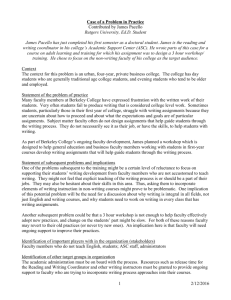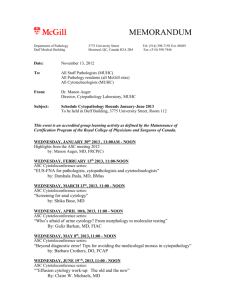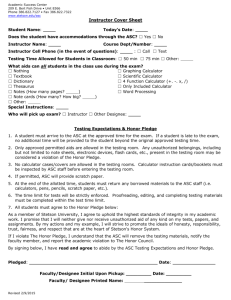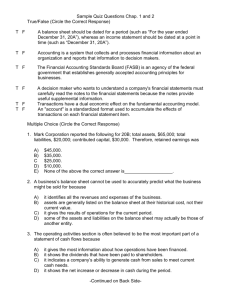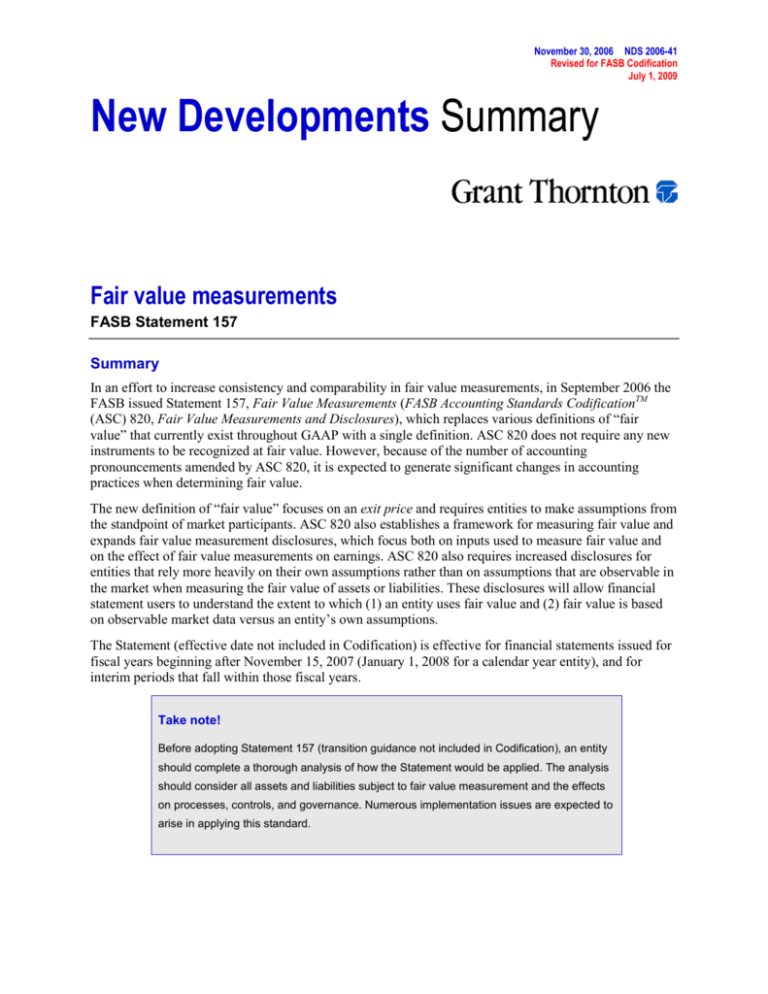
November 30, 2006 NDS 2006-41
Revised for FASB Codification
July 1, 2009
New Developments Summary
Fair value measurements
FASB Statement 157
Summary
In an effort to increase consistency and comparability in fair value measurements, in September 2006 the
FASB issued Statement 157, Fair Value Measurements (FASB Accounting Standards CodificationTM
(ASC) 820, Fair Value Measurements and Disclosures), which replaces various definitions of “fair
value” that currently exist throughout GAAP with a single definition. ASC 820 does not require any new
instruments to be recognized at fair value. However, because of the number of accounting
pronouncements amended by ASC 820, it is expected to generate significant changes in accounting
practices when determining fair value.
The new definition of “fair value” focuses on an exit price and requires entities to make assumptions from
the standpoint of market participants. ASC 820 also establishes a framework for measuring fair value and
expands fair value measurement disclosures, which focus both on inputs used to measure fair value and
on the effect of fair value measurements on earnings. ASC 820 also requires increased disclosures for
entities that rely more heavily on their own assumptions rather than on assumptions that are observable in
the market when measuring the fair value of assets or liabilities. These disclosures will allow financial
statement users to understand the extent to which (1) an entity uses fair value and (2) fair value is based
on observable market data versus an entity’s own assumptions.
The Statement (effective date not included in Codification) is effective for financial statements issued for
fiscal years beginning after November 15, 2007 (January 1, 2008 for a calendar year entity), and for
interim periods that fall within those fiscal years.
Take note!
Before adopting Statement 157 (transition guidance not included in Codification), an entity
should complete a thorough analysis of how the Statement would be applied. The analysis
should consider all assets and liabilities subject to fair value measurement and the effects
on processes, controls, and governance. Numerous implementation issues are expected to
arise in applying this standard.
Grant Thornton LLP
2
This bulletin summarizes ASC 820. It is not a substitute for reading and applying the specific guidance
referred to in ASC 820 and other applicable accounting literature.
Contents
A. Background ............................................................................................................................................ 2
B. Scope ...................................................................................................................................................... 3
C. New definition of fair value ................................................................................................................... 3
Unit of account ....................................................................................................................................... 3
Exit price definition ................................................................................................................................ 4
Orderly transaction ................................................................................................................................. 4
Market participants ................................................................................................................................. 4
Other provisions ..................................................................................................................................... 4
Amendments to existing guidance relating to pricing ............................................................................ 5
Blockage factors .............................................................................................................................. 5
Day-one gains .................................................................................................................................. 5
Restricted stock ................................................................................................................................ 5
D. Valuation ................................................................................................................................................ 5
Techniques.............................................................................................................................................. 5
Fair value hierarchy ................................................................................................................................ 6
Inputs based on bid and ask prices ......................................................................................................... 7
E. Disclosures ............................................................................................................................................. 7
Items measured on either a recurring or nonrecurring basis .................................................................. 7
Items measured on a recurring basis ................................................................................................ 8
Items measured on a nonrecurring basis .......................................................................................... 8
F. Effective date and transition (not included in Codification) .................................................................. 8
A. Background
The FASB has concluded in many accounting pronouncements that fair value information is relevant, and
users of financial statements generally have agreed. While the definitions of fair value in existing GAAP
vary, there is limited guidance for applying those definitions. The different definitions, coupled with a
lack of guidance, has created inconsistencies in financial statements and made it difficult for financial
statement users to compare entities. FASB Statement 157, Fair Value Measurements (FASB Accounting
Standards CodificationTM (ASC) 820, Fair Value Measurements and Disclosures), creates a single
definition of fair value, along with a conceptual framework to measure fair value, to increase consistency
and comparability in fair value measurements. ASC 820 also requires enhanced disclosures of fair value
measurements to increase consistency and comparability in financial statement disclosures.
ASC 820 is one in a series of recently issued or anticipated standards related to fair value as illustrated
below.
Statement or project
name
Description
Status
Statement 155 (ASC 825,
Derivatives and Hedging, 1525-4)
Accounting for Certain Hybrid Financial
Instruments: an amendment of FASB Statements
No. 133 and 140
Issued February 2006
Statement 156 (ASC 860,
Transfers and Servicing, 5035-1)
Accounting for Servicing of Financial Assets: an
amendment of FASB Statement No. 140
Issued March 2006
Grant Thornton LLP
3
Statement or project
name
Description
Status
Fair Value Option – Phase 1
Fair value option for financial assets and
financial liabilities
Expected in the 4 quarter of
2006
Fair Value Option – Phase 2
Fair value option for selected nonfinancial items
Board’s activity will commence
after Phase 1 is completed
Business combinations
Joint project between the FASB and the IASB to
create a single high-quality standard of
accounting for business acquisitions
Expected in the 2
2007
th
nd
quarter of
B. Scope
ASC 820 does not change existing accounting rules governing what can or what must be recognized and
reported at fair value in the financial statements, or disclosed at fair value in the notes to the financial
statements. Additionally, ASC 820 does not eliminate practicability exceptions that exist in accounting
pronouncements amended by ASC 820 when measuring fair value. ASC 820 applies to the measurement
of fair value, except for the following:
•
Share-based payment transactions measured under ASC 718, Compensation – Stock Compensation
(FASB Statement 123R, Share-Based Payment, and related pronouncements)
•
Transactions measured using vendor-specific objective evidence (VSOE) of fair value, such as those
accounted for under ASC 985, Software, 605-25-1 through 25-107 (AICPA Statement of Position 972, Software Revenue Recognition), and ASC 605, Revenue Recognition, 25-25-1 through 25-6 (EITF
Issue 00-21, “Revenue Arrangements with Multiple Deliverables”)
•
Inventory measured at the lower of cost or market under ASC 330, Inventory, 10-35-1 through 35-12
(FASB Accounting Research Bulletin 43, Chapter 4, Inventory Pricing)
While ASC 820 focuses on the fair value measurement of assets and liabilities, it is also applicable to
instruments measured at fair value and classified in stockholders’ equity.
C. New definition of fair value
ASC Glossary defines fair value as “the price that would be received to sell an asset or paid to transfer a
liability in an orderly transaction between market participants at the measurement date.” Although this
definition may sound familiar, it contains some distinct differences from existing definitions and may be
inconsistent with an entity’s past approach to measuring fair value. In defining fair value, ASC 820 breaks
down the definition further by clarifying or providing enhanced guidance about specific terms, as
discussed below.
Unit of account
An important first step in measuring fair value is determining the particular asset or liability that is being
measured consistent with its unit of account. The asset or liability may be a standalone asset or liability
(for example, a financial instrument or an operating asset) or a group of assets or liabilities (for example,
an asset group, a reporting unit, or a business).
Grant Thornton LLP
4
Exit price definition
The definition of fair value in ASC 820 focuses on the price that would be received to sell, or paid to
transfer, a liability (that is, an exit price) at the measurement date, not the price that would be paid to
acquire an asset, or received to assume a liability (an entry price). The price is based on the amount that
the holder of the asset or liability would receive or need to pay in an actual transaction (or in a
hypothetical transaction if an actual transaction does not exist) at the measurement date. For example, if
you purchased a new car (and drove it off the car dealer’s lot) on December 29, 200X for $20,000, the fair
value of the car on December 31, 200X might be based on the blue book value of a used car on December
31, 200X, not on the car’s original purchase price.
In many instances the entry price will equal the exit price at initial recognition; however, all facts and
circumstances must be considered.
Orderly transaction
The exit price definition assumes that the transaction has exposure to the market to allow for usual and
customary marketing activities and is not a forced transaction (such as bankruptcy or liquidation).
Market participants
Whether or not an active market exists for a certain asset or liability, the reporting entity is required to
consider assumptions that a market participant would use, not an entity’s own assumptions. The reporting
entity does not necessarily need to identify a specific market participant, but should identify
characteristics that distinguish these market participants. Market participants are buyers and sellers of
assets or liabilities in their principal (or most advantageous) market that have the following
characteristics:
•
Independent of (that is, unrelated to) the reporting entity
•
Knowledgeable with a reasonable understanding about the asset or liability and the transaction in
question
•
Willing and able to transact for the asset or liability
ASC 820 specifies that if a principal market exists, the fair value measurement should reflect the price in
that market, even if the price in another market is potentially more advantageous. The principal market is
the one with the greatest volume and level of activity where the reporting entity would sell the asset or
transfer the liability. The most advantageous market maximizes the amount that would be received for an
asset, or minimizes the amount paid for a liability, considering transaction costs (transaction costs are
used in determining the most advantageous market, however, fair value should not be adjusted to reflect
transaction costs). In addition, entities should consider the markets where the asset is purchased and the
asset is sold, since market participants may have access to different markets (for example, wholesale,
retail, and interdealer markets).
Other provisions
When measuring fair value, the reporting entity should also take into account these considerations:
•
Attributes specific to the asset or liability, such as its condition or location
•
An adjustment for risks (such as default risk or uncertainties) if market participants include an
adjustment in pricing; they should include this adjustment even if it is difficult to determine
•
Transportation costs to transfer the asset or liability to or from its principal (or most advantageous)
market
Grant Thornton LLP
5
•
Restrictions on the sale or use of an asset
•
The highest and best use, from a market participant’s viewpoint, that maximizes the value of an asset
or group of assets. The highest and best use may be in combination with other assets as a group (inuse) or on a standalone basis (in-exchange).
•
Nonperformance risk when measuring a liability such as, but not limited to, an entity’s own credit
standing
•
Unstated rights and privileges that should be separately measured if they are part of the transaction
price
Amendments to existing guidance relating to pricing
Blockage factors
ASC 820 prohibits entities from adjusting quoted prices for premiums or discounts based on the relative
size of the position held, such as a large proportion of total trading units of an instrument (called the
blockage factor). It also amends the exemption for investment companies and broker-dealers provided in
the respective AICPA Audit and Accounting Guides, which permit entities under the scope of those
guides to apply blockage factors.
Day-one gains
ASC 820 nullifies the exception in footnote 3 of EITF Issue 02-3, “Issues Involved in Accounting for
Derivative Contracts Held for Trading Purposes and Contracts Involved in Energy Trading and Risk
Management Activities,” (not included in Codification) which prohibits recognition of day-one gains if
the fair value is based on unobservable (level 3) inputs.
Additionally, ASC 820 amends FASB Statement 155, Accounting for Certain Hybrid Financial
Instruments: an amendment of FASB Statements No. 133 and 140, (not included in Codification) which
requires an entity to initially measure a hybrid financial instrument at fair value using the transaction
price.
Restricted stock
ASC 820 amends the guidance in FASB Statement 115, Accounting for Certain Investments in Debt and
Equity Securities, (original guidance not included in Codification) by requiring companies holding
securities that are restricted from being sold for one year or less to reduce the fair value of those securities
from the quoted price of identical unrestricted securities if a market participant would consider that
restriction in pricing the security.
D. Valuation
Techniques
ASC 820 requires the application of valuation techniques that place greater reliance on observable inputs
and less reliance on unobservable inputs. It also emphasizes that the valuation techniques used to measure
fair value should be consistent with the market approach, the income approach, and/or the cost approach,
as follows:
•
Market approach: The market approach (or sales comparison approach) uses prices and other relevant
information observable in market transactions involving identical or comparable assets or liabilities.
This approach is based on the premise that a market participant will not pay more than it costs to
purchase a similar asset.
Grant Thornton LLP
6
•
Income approach: The income approach uses valuation techniques to convert future amounts
(economic benefits or sacrifices of economic benefits) to determine what future amounts are worth as
of the valuation date. Typically this approach converts cash flows or earnings using valuation
techniques such as option pricing, discounted cash flow, and earnings capitalization models. It is
based on the premise that a market participant is willing to pay the present value of the future
economic benefits of an asset.
•
Cost approach: The cost approach utilizes valuation techniques to determine the amount required to
acquire or construct a substitute asset adjusted for obsolescence. This is often referred to as the
replacement cost. The cost approach typically does not consider market conditions and therefore is
not usually used in practice, except to determine the fair value of a customized piece of machinery or
in construction.
Depending on the circumstances, a single or multiple valuation technique may be appropriate. Choosing a
valuation approach is typically dependent on (1) the highest and best use of an asset or a group of assets
by a market participant that maximizes their value and (2) the availability of sufficient data in applying
the technique. If multiple valuation techniques are used, the amount within that range of amounts that is
most representative of fair value in the circumstances would be applied.
Fair value hierarchy
To increase consistency and comparability in applying fair value measurements, ASC 820 establishes a
fair value hierarchy that does not prioritize the valuation techniques, but rather the inputs used to measure
fair value. The highest priority is given to quoted prices in active markets for identical assets or liabilities
obtained from independent sources (level 1), and the lowest priority is given to unobservable inputs based
on an entity’s own assumptions (level 3). Determining where an asset falls within that hierarchy depends
on the lowest level input that is significant to the fair value measurement as a whole. Additionally, an
adjustment to the pricing method used within either level 1 or level 2 inputs could generate a fair value
measurement that effectively falls in a lower level in the hierarchy.
The Fair Value Hierarchy
Level
Inputs
Input examples
Level 1
Quoted market prices in active
markets for identical assets or
liabilities
Prices from exchange-traded
markets (NYSE, NASDAQ) and
dealer markets (over-the-counter
markets)
Level 2
Inputs other than level 1 inputs that
are either directly or indirectly
observable, including:
•
Quoted prices for similar assets
or liabilities in active markets
Common stock of a public company
that is restricted from sale under Rule
144
•
Quoted prices for identical
assets or liabilities in markets
that are inactive
Brokered markets for unrestricted
securities such as registered debt
Potential
examples of
instruments
Exchange-traded
investments, futures,
actively traded
bonds, and actively
traded debt
Restricted
investments,
secondary market
loans, plain vanilla
interest and credit
swaps, buildings held
and used
Grant Thornton LLP
7
The Fair Value Hierarchy
Level
Level 3
Inputs
Input examples
•
Quoted prices for similar assets
or liabilities in markets that are
inactive
Brokered markets such as residential
or commercial real estate markets
•
Inputs other than quoted prices
that are observable
Interest rates and yield curves at
commonly quoted intervals, implied
volatilities, prepayment speeds, loss
severities, credit risks, default rates
•
Inputs not directly observable,
but derived principally from, or
corroborated by, observable
market data
Multiples of earnings, revenues, or
similar performance measures
Unobservable inputs developed
using the reporting entities’ estimates
and assumptions, which reflect those
that market participants would use
Expected cash flows, historical
volatility, or forward prices for
commodities beyond the term for
which observable quotes exist
Potential
examples of
instruments
Mortgage servicing
rights, complex
derivatives, private
equity, long-dated
derivatives, and
asset retirement
obligations
Inputs based on bid and ask prices
When bid/ask prices are used, the reporting entity should choose the point within the bid/ask price range
that is most representative of fair value in the particular circumstances. ASC 820 does not preclude the
use of mid-market or other pricing conventions. Additionally, ASC 820 permits, but does not require, the
use of bid prices for long positions (assets) and ask prices for short positions (liabilities). This approach is
consistent with the SEC Accounting Series Release (ASR) 118, Accounting for Investment Securities by
Registered Investment Companies.
E. Disclosures
The disclosures required by ASC 820 focus on the inputs used to measure fair value, the effect of
measurements on earnings, and the increased disclosures if entities rely on their own assumptions (level
3) when pricing assets or liabilities. ASC 820 encourages, but does not require, an entity to combine the
newly required disclosures with fair value information disclosed under other accounting pronouncements.
ASC 820 requires disclosures for each interim and annual period (except as noted below) for each major
asset and liability category, which must be split into two separate groups representing those that are
measured on a recurring basis (for example, trading securities) and on a nonrecurring basis (an
impairment charge, for instance, to write down an asset to fair value). Quantitative information must be
disclosed in tabular format.
Items measured on either a recurring or nonrecurring basis
For all fair value measurements, the following disclosures are required:
Grant Thornton LLP
8
•
Fair value measurements for each major asset and liability categorized by where the measurement
falls in the fair value hierarchy
•
In annual periods only, and in interim periods that fall within the year when Statement 157 (transition
guidance not included in Codification) is adopted, a description of the valuation techniques (methods
and assumptions) used to measure fair value and a discussion of changes, if any, in the valuation
techniques used. Changes in valuation techniques or their application are accounted for as changes in
accounting estimates.
Items measured on a recurring basis
For fair value measurements using significant level 3 inputs, the following disclosures are required:
•
A reconciliation of the beginning and ending balance of each major category of assets and liabilities
(except derivative assets and liabilities, which may be presented net), with a separate presentation of
changes during the period attributable to the following:
−
Gains and/or losses segregated between those included in earnings and those included in other
comprehensive income
−
Purchases, sales, issuances, and settlements (net)
−
Transfers in and/or out of level 3
•
Disclosure of which statement of income classification(s) realized gains and losses are reported
•
Disclosure of which statement of income classification(s) the unrealized gains or losses relating to
assets and liabilities still held at the reporting date are reported
•
The amount of total gains and/or losses for the period included in earnings attributable to changes in
unrealized gains or losses relating to assets and/or liabilities held at the reporting date, as well as
where those gains and/or losses are reported in the income statement (with separate disclosure for
assets and liabilities)
Items measured on a nonrecurring basis
For items measured at fair value on a nonrecurring basis, the following disclosures are required:
•
Fair value measurements recorded during the period and the reasons for the measurements
•
For fair value measurements using significant level 3 inputs, a description of the inputs and
information used to develop the inputs
F. Effective date and transition (not included in Codification)
The Statement is effective for financial statements issued for fiscal years beginning after November 15,
2007 (January 1, 2008 for calendar-year entities), and for interim periods that fall within those fiscal
years. Early application is encouraged if financial statements for the fiscal year, including interim periods
within that year, have not yet been issued. Generally this Statement should be applied prospectively as of
the beginning of the year in which the Statement is initially applied.
The Statement should be applied retrospectively by recognizing a cumulative effect adjustment to the
beginning balance of retained earnings for the fiscal year of adoption, but only in the following
circumstances:
Grant Thornton LLP
•
If an entity has been applying the exception for investment companies and broker-dealers in the
respective AICPA Audit and Accounting Guides, which permit entities to adjust quoted prices for
blockage factors prior to the adoption of Statement 157
•
If an entity has been applying the exception in footnote 3 of EITF Issue 02-3, which prohibits the
recognition of day-one gains if the contract’s fair value is based on unobservable inputs (level 3
inputs) prior to the adoption of Statement 157
•
If an entity initially measures a hybrid financial instrument at fair value using the transaction price
(and therefore not recognizing day-one gains) in accordance with the guidance in Statement 155
before adopting Statement 157
9
The disclosure requirements of Statement 157 must be presented only for periods to which this Statement
applies.
© 2006 Grant Thornton LLP, U.S. Member of Grant Thornton International. All rights reserved.
This Grant Thornton LLP bulletin provides information and comments on current accounting issues and
developments. It is not a comprehensive analysis of the subject matter covered and is not intended to
provide accounting or other advice or guidance with respect to the matters addressed in the bulletin. All
relevant facts and circumstances, including the pertinent authoritative literature, need to be considered to
arrive at conclusions that comply with matters addressed in this bulletin.
For additional information on topics covered in this bulletin, contact your Grant Thornton LLP adviser.


